Trigonometry
- Two posts are x metres apart and the height of one is double that of the other. If from the mid-point of the line joining their feet, an observer finds the angular elevations of their tops to be complementary, then the height (in metres) of the shorter post is
-
View Hint View Answer Discuss in Forum
CD = h metre, AB = 2h metre
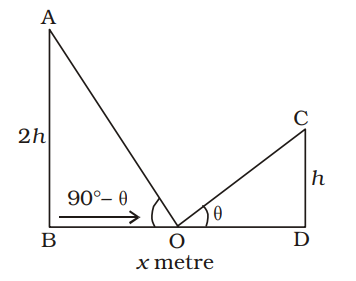
OB = OD = x metre 2
From ∆OCD,tan θ = h = 2h ..........(i) x x 2
From ∆OAB,tan (90° – θ) = AB BO ⇒ cotθ = 2h = 4h ..........(ii) x x 2
Multiplying both equations,tanθ .cotθ = 2h × 4h x x
⇒ x2 = 8h2
[∵ tanθcotθ = 1]⇒ h2 = x2 8 ⇒ h = x metre 2√2 Correct Option: A
CD = h metre, AB = 2h metre

OB = OD = x metre 2
From ∆OCD,tan θ = h = 2h ..........(i) x x 2
From ∆OAB,tan (90° – θ) = AB BO ⇒ cotθ = 2h = 4h ..........(ii) x x 2
Multiplying both equations,tanθ .cotθ = 2h × 4h x x
⇒ x2 = 8h2
[∵ tanθcotθ = 1]⇒ h2 = x2 8 ⇒ h = x metre 2√2
- The angle of elevation of the top of a building and the top of the chimney on the roof of the building from a point on the ground are x and 45° respectively. The height of building is h metre. Then the height of the chimney, (in metre) is :
-
View Hint View Answer Discuss in Forum
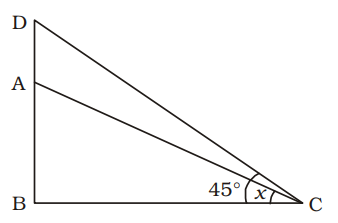
AB = Buidling = h metre
AD = Chimney = y metre
From ∆BCD,tan45° = BD BC ⇒ 1 = h + y BC
⇒ BC = h + y ..... ... (i)
From ∆ABC,tan x = AB BC ⇒ tan x = h BC
⇒ BC = h cot x ...........(ii)
From equations (i) and (ii),
h + y = h cot x
⇒ y = (h cot x – h) metreCorrect Option: B

AB = Buidling = h metre
AD = Chimney = y metre
From ∆BCD,tan45° = BD BC ⇒ 1 = h + y BC
⇒ BC = h + y ..... ... (i)
From ∆ABC,tan x = AB BC ⇒ tan x = h BC
⇒ BC = h cot x ...........(ii)
From equations (i) and (ii),
h + y = h cot x
⇒ y = (h cot x – h) metre
- A telegraph post is bent at a point above the ground due to storm. Its top just meets the ground at a distance of 8 √3 metres from its foot and makes an angle of 30°, then the height of the post is :
-
View Hint View Answer Discuss in Forum
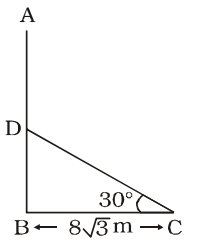
AB = Telegraph post = h metre
Telegraph post bends at point D.
DB = x metre
∴ AD = CD = (h – x) metre
BC = 8 √3 metre
From, ∆ DBC,sin 30° = DB DC ⇒ 1 = x ⇒ 2x = h - x 2 h - x
⇒ 3x = h ......... (i)
Again,tan 30° = DB BC ⇒ 1 = x √3 8√3
⇒ x = 8 metre
∴ h = 3 × 8 = 24 metreCorrect Option: C

AB = Telegraph post = h metre
Telegraph post bends at point D.
DB = x metre
∴ AD = CD = (h – x) metre
BC = 8 √3 metre
From, ∆ DBC,sin 30° = DB DC ⇒ 1 = x ⇒ 2x = h - x 2 h - x
⇒ 3x = h ......... (i)
Again,tan 30° = DB BC ⇒ 1 = x √3 8√3
⇒ x = 8 metre
∴ h = 3 × 8 = 24 metre
- Two poles of equal height are standing opposite to each other on either side of a road which is 100 m wide. From a point between them on road, angle of elevation of their tops are 30° and 60°. The height of each pole (in metre) is
-
View Hint View Answer Discuss in Forum
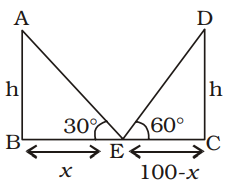
AB = CD = h metre (Height of pole)
From ∆ABE,tan 30° = h x ⇒ 1 = h ⇒ √3h = x .........(i) √3 x
From ∆DEC,tan 60° = h 100 - x ⇒ √3 = h 100 - x
⇒ √3 ( 100 - x) = h
⇒ √3 (100 - √3h) = h
[From equation (i)]
⇒ 100 √3 - 3h ⇒ 4h = 100√3
⇒ h = 25 √3 metreCorrect Option: A

AB = CD = h metre (Height of pole)
From ∆ABE,tan 30° = h x ⇒ 1 = h ⇒ √3h = x .........(i) √3 x
From ∆DEC,tan 60° = h 100 - x ⇒ √3 = h 100 - x
⇒ √3 ( 100 - x) = h
⇒ √3 (100 - √3h) = h
[From equation (i)]
⇒ 100 √3 - 3h ⇒ 4h = 100√3
⇒ h = 25 √3 metre
- The angle of elevation of the top of a tower from a point A on the ground is 30°. On moving a distance of 20 metres towards the foot of the tower to a point B, the angle of elevation increases to 60°. The height of the tower is
-
View Hint View Answer Discuss in Forum
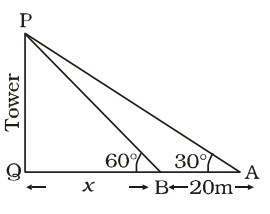
Let PQ = h metre and BQ = x metre.
From ∆ APQ,tan30° = h x + 20 ⇒ 1 = h √3 x + 20
⇒ √3h = x + 20 ...........(i)
From ∆ PQB,tan 60° = PQ = h BQ x ⇒ √3 = h ⇒ h = √3x x ⇒ x = 1 h .......(ii) √3 ∴ √3h = 1 h + 20 √3
[From equation (i) and (ii)]
⇒ 3h – h = 20 √3
⇒ 2h = 20 √3
∴ h = 10 √3 metreCorrect Option: C

Let PQ = h metre and BQ = x metre.
From ∆ APQ,tan30° = h x + 20 ⇒ 1 = h √3 x + 20
⇒ √3h = x + 20 ...........(i)
From ∆ PQB,tan 60° = PQ = h BQ x ⇒ √3 = h ⇒ h = √3x x ⇒ x = 1 h .......(ii) √3 ∴ √3h = 1 h + 20 √3
[From equation (i) and (ii)]
⇒ 3h – h = 20 √3
⇒ 2h = 20 √3
∴ h = 10 √3 metre

